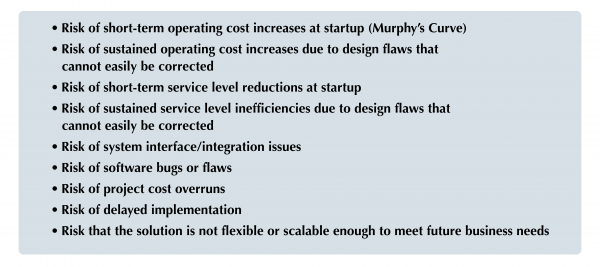Commonwealth Supply Chain Advisors recently published a ground-breaking white-paper titled, “Beating Murphy’s Law in Warehouse Automation Projects.” The full paper examines a number of the reasons why automation projects fail to meet expectations, and what companies can do to beat Murphy’s Law. This blog is third in an ongoing series on “Beating Murphy’s Law in Warehouse Automation Projects.” 
A good first step towards accounting for Murphy’s Curve is to perform a risk assessment on each of the potential solution scenarios being considered. Often, the technology that holds the greatest promise of cost savings can also involve the greatest risk of failure. Certain forms of warehouse automation may be very unforgiving of minor design flaws or changing business conditions, while other technologies may be more flexible and adaptable to these forms of change. Other technologies may seem promising but may be relatively new and untested in the marketplace. Companies seeking aggressive cost savings can often be blind to the risks inherent in some technologies. A thorough risk assessment can be an effective way to highlight these risks and impact the choice of design and technology early in the project. To perform a risk assessment, start by identifying the specific risks which are present on the project. Examples of risks to account for include:

Next, assign each risk a weight factor based upon your company’s tolerance for risk in this area. For example, the company may be relatively unconcerned with the risk of cost overruns compared to the risk of the project not going live on time prior to a peak demand period. These two risks should be weighted differently. Lastly, give each potential solution scenario a numeric rating for each of the risk areas (a low score represents low risk, a high score represents high risk). Multiply this rating by the weighting factor to achieve a weighted risk score for each solution scenario. It may be discovered that certain solutions that offer the highest potential for labor savings may also have the highest risk of cost or schedule overruns. As a result, the company may choose a solution that is less automated, but less risky, or may choose to proceed with the riskier technology and build in contingency factors for cost and time overruns. To read Commonwealth’s complete white-paper titled, Beating Murphy’s Law in Warehouse Automation Projects, click here.
